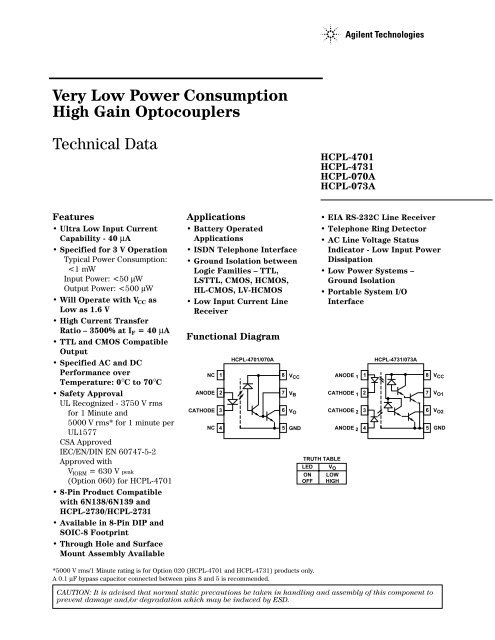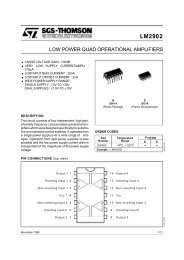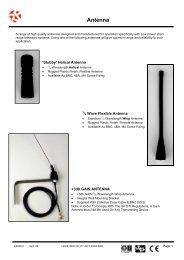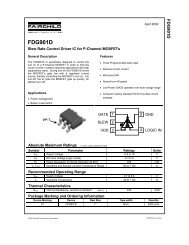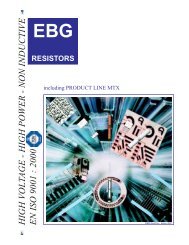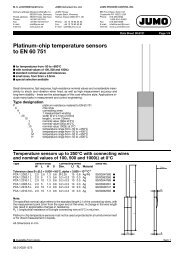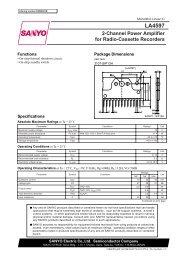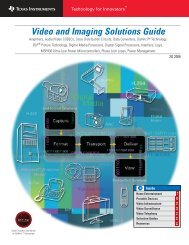You also want an ePaper? Increase the reach of your titles
YUMPU automatically turns print PDFs into web optimized ePapers that Google loves.
Very Low Power ConsumptionHigh Gain OptocouplersTechnical DataHCPL-4701HCPL-4731HCPL-070AHCPL-073AFeatures• Ultra Low Input CurrentCapability - 40 µA• Specified for 3 V OperationTypical Power Consumption:
2DescriptionThese devices are very low powerconsumption, high gain singleand dual channel optocouplers.The HCPL-4701 represents thesingle channel 8-Pin DIP configurationand is pin compatible withthe industry standard 6N139. TheHCPL-4731 represents the dualchannel 8-Pin DIP configurationand is pin compatible with thepopular standard HCPL-2731.The HCPL-070A and HCPL-073Aare the equivalent single and dualchannel products in an SO-8footprint. Each channel can bedriven with an input current aslow as 40 µA and has a typicalcurrent transfer ratio of 3500%.These high gain couplers use anAlGaAs LED and an integratedhigh gain photodetector toprovide an extremely highcurrent transfer ratio betweeninput and output. Separate pinsfor the photodiode and outputstage results in TTL compatiblesaturation voltages and highspeed operation. Where desired,the V CC and V O terminals may betied together to achieve conventionalDarlington operation(single channel package only).These devices are designed foruse in CMOS, LSTTL or other lowpower applications. They areespecially well suited for ISDNtelephone interface and batteryoperated applications due to thelow power consumption. A 700%minimum current transfer ratio isguaranteed from 0°C to 70°Coperating temperature range at40 µA of LED current andV CC ≥ 3V.The SO-8 does not require“through holes” in a PCB. Thispackage occupies approximatelyone-third the footprint area of thestandard dual-in-line package.The lead profile is designed to becompatible with standard surfacemount processes.Selection GuideWidebody8-Pin DIP Package Hermetic(300 Mil) Small Outline SO-8 (400 mil) Single andDual Single Dual Minimum Absolute DualSingle Channel Channel Channel Single Input ON Maxi- ChannelChannel Package Package Package Channel Current Minimum mum PackagesPackage HCPL- HCPL- HCPL- Package (I F ) CTR V CC HCPL-6N139 [1] 2731 [1] 0701 [1] 0731 [1] HCNW139 [1] 0.5 mA 400% 18 V6N138 [1] 2730 [1] 0700 [1] 0730 [1] HCNW138 [1] 1.6 mA 300% 7 VHCPL-4701 4731 070A 0730A 40 µA 800% 18 V0.5 mA 300% 20 V 5701 [1]5700 [1]5731 [1]5730 [1]Notes:1. Technical data are on separate Agilent publication.
3Ordering InformationSpecify Part Number followed by Option Number (if desired).Example:HCPL-4701#XXXX020 = 5000 V rms/1 minute UL Rating Option.**060 = IEC/EN/DIN EN 60747-5-2 V IORM = 630 V peak Option†300 = Gull Wing Surface Mount Option.*500 = Tape and Reel Packaging Option.XXXE = Lead Free Option*Gull wing surface mount option applies to through hole parts only.**For HCPL-4701 and HCPL-4731 (8-Pin DIP products) only.†For HCPL-4701 only. Combination of Option 020 and Option 060 is not available.Option data sheets available. Contact your Agilent sales representative or authorized distributor for information.Remarks: The notation “#” is used for existing products, while (new) products launched since 15th July 2001 and lead free option will use “–”SchematicHCPL-4701 and HCPL-070AHCPL-4731 and HCPL-073A2ANODE+V F–CATHODE3V CC8I CCI FSHIELDI O 6V OI B7V B5GND1+V F1–23–V F2+4I I F1 CCVCC8I O1VO17I O2V O26I F2SHIELDGND5USE OF A 0.1 µF BYPASS CAPACITOR CONNECTEDBETWEEN PINS 5 AND 8 IS RECOMMENDED (SEE NOTE 8)
4Package Outline Drawings8-Pin DIP Package (HCPL-4701, HCPL-4731)9.65 ± 0.25(0.380 ± 0.010)7.62 ± 0.25(0.300 ± 0.010)TYPE NUMBER8765OPTION CODE*6.35 ± 0.25(0.250 ± 0.010)A XXXXZDATE CODEYYWW12341.19 (0.047) MAX.1.78 (0.070) MAX.3.56 ± 0.13(0.140 ± 0.005)4.70 (0.185) MAX.5° TYP.0.254 + 0.076- 0.051(0.010 + 0.003)- 0.002)1.080 ± 0.320(0.043 ± 0.013)2.92 (0.115) MIN.0.65 (0.025) MAX.2.54 ± 0.25(0.100 ± 0.010)0.51 (0.020) MIN.DIMENSIONS IN MILLIMETERS AND (INCHES).*MARKING CODE LETTER FOR OPTION NUMBERS"L" = OPTION 020"V" = OPTION 060OPTION NUMBERS 300 AND 500 NOT MARKED.NOTE: FLOATING LEAD PROTRUSION IS 0.25 mm (10 mils) MAX.8-Pin DIP Package with Gull Wing Surface Mount Option 300 (HCPL-4701, HCPL-4731)LAND PATTERN RECOMMENDATION9.65 ± 0.25(0.380 ± 0.010)1.016 (0.040)87656.350 ± 0.25(0.250 ± 0.010)10.9 (0.430)12341.27 (0.050)2.0 (0.080)1.19(0.047)MAX.1.780(0.070)MAX.3.56 ± 0.13(0.140 ± 0.005)9.65 ± 0.25(0.380 ± 0.010)7.62 ± 0.25(0.300 ± 0.010)0.254 + 0.076- 0.051(0.010 + 0.003)- 0.002)1.080 ± 0.320(0.043 ± 0.013)2.540.635 ± 0.130(0.100)(0.025 ± 0.005)BSCDIMENSIONS IN MILLIMETERS (INCHES).LEAD COPLANARITY = 0.10 mm (0.004 INCHES).0.635 ± 0.25(0.025 ± 0.010)12° NOM.NOTE: FLOATING LEAD PROTRUSION IS 0.25 mm (10 mils) MAX.
5Small-Outline SO-8 Package (HCPL-070A, HCPL-073A)LAND PATTERN RECOMMENDATION3.937 ± 0.127(0.155 ± 0.005)PIN ONE18 7 6 52XXXYWW0.406 ± 0.076(0.016 ± 0.003) 1.270(0.050) BSC345.994 ± 0.203(0.236 ± 0.008)TYPE NUMBER(LAST 3 DIGITS)DATE CODE0.64 (0.025)1.9 (0.075)7.49 (0.295)* 5.080 ± 0.127(0.200 ± 0.005)7°45° X 0.432(0.017)3.175 ± 0.127(0.125 ± 0.005)1.524(0.060)0.228 ± 0.025(0.009 ± 0.001)* TOTAL PACKAGE LENGTH (INCLUSIVE OF MOLD FLASH)5.207 ± 0.254 (0.205 ± 0.010)DIMENSIONS IN MILLIMETERS (INCHES).LEAD COPLANARITY = 0.10 mm (0.004 INCHES) MAX.0.305(0.012) MIN.0.203 ± 0.102(0.008 ± 0.004)NOTE: FLOATING LEAD PROTRUSION IS 0.15 mm (6 mils) MAX.Solder Reflow Thermal ProfileTEMPERATURE (°C)300200100PREHEATING RATE 3°C + 1°C/–0.5°C/SEC.REFLOW HEATING RATE 2.5°C ± 0.5°C/SEC.160°C150°C140°C3°C + 1°C/–0.5°C2.5°C ± 0.5°C/SEC.PREHEATING TIME150°C, 90 + 30 SEC.PEAKTEMP.245°C30SEC.30SEC.50 SEC.PEAKTEMP.240°CSOLDERINGTIME200°CPEAKTEMP.230°CROOMTEMPERATURE00TIGHTTYPICALLOOSE50 100 150200 250TIME (SECONDS)Figure 1a. Solder Reflow Thermal Profile.
6Recommended Pb-Free IR ProfileTEMPERATURET p260 +0/-5 °CT L217 °CRAMP-UP3 °C/SEC. MAX.T smax150 - 200 °CT smin25t sPREHEAT60 to 180 SEC.t 25 °C to PEAKFigure 1b. Pb-Free IR Profile.t pt LTIME WITHIN 5 °C of ACTUALPEAK TEMPERATURE20-40 SEC.RAMP-DOWN6 °C/SEC. MAX.60 to 150 SEC.TIMENOTES:THE TIME FROM 25 °C to PEAK TEMPERATURE = 8 MINUTES MAX.T smax = 200 °C, T smin = 150 °CRegulatory InformationThe HCPL-4701/4731 and HCPL-070A/073A have been approvedby the following organizations:ULRecognized under UL 1577,Component RecognitionProgram, File E55361.CSAApproved under CSA ComponentAcceptance Notice #5, File CA88324.IEC/EN/DIN EN 60747-5-2Approved under:IEC 60747-5-2:1997 + A1:2002EN 60747-5-2:2001 + A1:2002DIN EN 60747-5-2 (VDE 0884Teil 2):2003-01.(Option 060 only)Insulation Related Specifications8-Pin DIP(300 Mil) SO-8Parameter Symbol Value Value Units ConditionsMinimum External Air L(101) 7.1 4.9 mm Measured from input terminals toGap (Externaloutput terminals, shortest distanceClearance)through air.Minimum External L(102) 7.4 4.8 mm Measured from input terminals toTracking (Externaloutput terminals, shortest distanceCreepage)path along body.Minimum Internal Plastic 0.08 0.08 mm Through insulation distance, conductorGap (Internal Clearance)to conductor, usually the directdistance between the photoemitter andphotodetector inside the optocouplercavity.Tracking Resistance CTI 200 200 Volts DIN IEC 112/ VDE 0303 Part 1(Comparative TrackingIndex)Isolation Group IIIa IIIa Material Group DIN VDE 0110,1/89, Table 1)Option 300 – surface mount classification is Class A in accordance with CECC 00802.
7IEC/EN/DIN EN 60747-5-2 Insulation Related Characteristics (HCPL-4701 OPTION 060 ONLY)Description Symbol Characteristic UnitsInstallation classification per DIN VDE 0110/1.89, Table 1for rated mains voltage ≤ 300 V rmsfor rated mains voltage ≤ 450 V rmsClimatic Classification 55/85/21Pollution Degree (DIN VDE 0110/1.89) 2Maximum Working Insulation Voltage V IORM 630 V peakInput to Output Test Voltage, Method b*V IORM x 1.87 = V PR , 100% Production Test with t m = 1 sec, V PR 1181 V peakPartial Discharge < 5 pCInput to Output Test Voltage, Method a*V IORM x 1.5 = V PR , Type and sample test, V PR 945 V peakt m = 60 sec, Partial Discharge < 5 pCHighest Allowable Overvoltage*(Transient Overvoltage, t ini = 10 sec) V IOTM 6000 V peakSafety Limiting Values(Maximum values allowed in the event of a failure,also see Figure 16, Thermal Derating curve.)Case Temperature T S 175 °CInput Current I S,INPUT 230 mAOutput Power P S,OUTPUT 600 mWInsulation Resistance at T S , V IO = 500 V R S >10 9 ΩI-IVI-III*Refer to the front of the optocoupler section of the current catalog, under Product Safety Regulations section, IEC/EN/DIN EN60747-5-2, for a detailed description.Note: Isolation characteristics are guaranteed only within the safety maximum ratings which must be ensured by protective circuits inapplication.
8Absolute Maximum Ratings(No Derating Required up to 70°C)Parameter Symbol Minimum Maximum UnitsStorage Temperature T S -55 125 °COperating Temperature T A -40 85 °CAverage Forward Input Current (HCPL-4701/4731) I F(AVG) 10 mAAverage Forward Input Current (HCPL-070A/073A) I F(AVG) 5 mAPeak Transient Input Current (HCPL-4701/4731) I FPK 20 mA(50% Duty Cycle, 1 ms Pulse Width)Peak Transient Input Current (HCPL-070A/073A) I FPK 10 mA(50% Duty Cycle, 1 ms Pulse Width)Reverse Input Voltage V R 2.5 VInput Power Dissipation (Each Channel) P I 15 mWOutput Current (Each Channel) I O 60 mAEmitter Base Reverse Voltage (HCPL-4701/070A) V EB 0.5 VOutput Transistor Base Current (HCPL-4701/070A) I B 5 mASupply Voltage V CC -0.5 18 VOutput Voltage V O -0.5 18 VOutput Power Dissipation (Each Channel) P O 100 mWTotal Power Dissipation (Each Channel) P T 115 mWLead Solder Temperature (for Through Hole Devices)260°C for 10 sec., 1.6 mm below seating planeReflow Temperature Profile See Package Outline Drawings section(for SOIC-8 and Option #300)Recommended Operating ConditionsParameter Symbol Min. Max. UnitsPower Supply Voltage V CC * 1.6 18 VForward Input Current (ON) I F(ON) 40 5000 µAForward Input Voltage (OFF) V F(OFF) 0 0.8 VOperating Temperature T A 0 70 °C*See Note 1.
9Electrical Specifications0°C ≤ T A ≤ 70°C, 4.5 V ≤ V CC ≤ 20 V, 1.6 mA ≤ I F(ON) ≤ 5 mA, 0 V ≤ V F(OFF) ≤ 0.8 V, unless otherwisespecified. All Typicals at T A = 25°C. See note 8.DeviceParameter Symbol HCPL- Min. Typ.* Max. Units Test Conditions Fig. NoteCurrent CTR 800 3500 25k % I F = 40 µA, V O = 0.4 V 4, 5 2TransferV CC = 4.5 VRatio600 3000 8k I F = 0.5 mA,V CC = 4.5 V700 3200 25k I F = 40 µA500 2700 8k I F = 0.5 mALogic Low V OL 0.06 0.4 V I F = 40 µA, I O = 280 µA 2, 3Output Voltage0.04 0.4 I F = 0.5 mA, I O = 2.5 mALogic High I OH 0.01 5 µA V O = V CC = 3 to 7 V,Output CurrentI F = 0 mA0.02 80 V O = V CC = 18 V,I F = 0 mALogic Low I CCL 4701/070A 0.02 0.2 mA I F = 40 µA V O = OpenSupply Current0.1 1 I F = 0.5 mA4731/073A 0.04 0.4 I F = 40 µA0.2 2.0 I F = 0.5 mALogic High I CCH 4701/070A
10Switching Specifications (AC)Over Recommended Operating Conditions T A = 0°C to 70°C, V CC = 3 V to 18 V, unless otherwise specified.DeviceParameter Symbol HCPL- Min. Typ.* Max. Units Test Conditions Fig. NotePropagation t PHL 65 500 µs I F = 40 µA, R L = 11 to 16 kΩ, 7, 9 9, 10Delay TimeV CC = 3.3 to 5 Vto Logic Low3 25 T A = 25°C I F = 0.5 mA,at Output30R L = 4.7 kΩPropagation t PLH 70 500 µs I F = 40 µA, R L = 11 to 16 kΩ, 7, 9 9, 10Delay TimeV CC = 3.3 to 5 Vto Logic High34 60 T A = 25°C I F = 0.5 mA,Output4701/4731 90R L = 4.7 kΩ070A/073A 130Common Mode |CM H | 1,000 10,000 V/µs I F = 0 mA, R L = 4.7 to 11 kΩ, 8 6, 7Transient V CM = 10 V p-p ,Immunity atT A = 25°C,Logic HighOutputCommon Mode |CM L | 1,000 10,000 V/µs I F = 0.5 mA, R L = 4.7 to 11 kΩ, 8 6, 7Transient |V CM | = 10 V p-p ,Immunity at T A = 25°CLogic LowOutput2,000 I F = 40 µA, R L = 11 to 16 kΩ,|V CM | = 10 V p-pV CC = 3.3 to 5 V, T A = 25°C*All typical values at T A = 25°C and V CC = 5 V, unless otherwise noted.Package CharacteristicsDeviceParameter Symbol HCPL- Min. Typ.* Max. Units Test Conditions Fig. NoteInput-Output Momentary V ISO 3750 V rms RH ≤ 50%, 3, 4Withstand Voltage**t = 1 min.,Option 020 4701 5000T A = 25°C3, 4a4731Resistance R I-O 10 12 Ω V I-O = 500 VDC 3(Input-Output) RH ≤ 45%Capacitance C I-O 0.6 pF f = 1 MHz 3(Input-Output)Insulation Leakage I I-I 4731 0.005 µA RH ≤ 45%, t = 5 s, 5Current (Input-Input) 073A V I-I = 500 VDCResistance (Input-Input) R I-I 10 11 ΩCapacitance C I-I 4731 0.03 pF f = 1 MHz 5(Input-Input) 073A 0.25*All typical values at T A= 25°C and V CC= 5 V.**The Input-Output Momentary Withstand Voltage is a dielectric voltage rating that should not be interpreted as an input-outputcontinuous voltage rating. For the continuous voltage rating refer to the IEC/EN/DIN EN 60747-5-2 Insulation CharacteristicsTable (if applicable), your equipment level safety specification or Agilent Application Note 1074 entitled “Optocoupler Input-Output Endurance Voltage.”
11Notes:1. Specification information is availableform the factory for 1.6 V operation.Call your local field sales office forfurther information.2. DC CURRENT TRANSFER RATIO isdefined as the ratio of outputcollector current, I O , to the forwardLED input current, I F , times 100%.3. Device considered a two terminaldevice: pins 1, 2, 3, and 4 shortedtogether, and pins 5, 6, 7, and 8shorted together.4. In accordance with UL 1577, eachoptocoupler is proof tested byapplying an insulation test voltage≥ 4500 V RMS for 1 second (leakagedetection current limit, I I-O ≤ 5 µA.4a. In accordance with UL 1577, eachoptocoupler is proof tested byapplying an insulation test voltage≥ 6000 V RMS for 1 second (leakagedetection current limit, I I-O ≤ 5 µA.This test is performed before the100% production test for partialdischarge (Method b) shown in theIEC/EN/DIN EN 60747-5-2 InsulationCharacteristics Table.5. Measured between pins 1 and 2shorted together, and pins 3 and 4shorted together.6. Common transient immunity in aLogic High level is the maximumtolerable (positive) dV CM /dt on theleading edge of the common modepulse, V CM , to assure that the outputwill remain in a Logic High state (i.e.,V O > 2.0 V). Common transientimmunity in a Logic Low level is hemaximum tolerable (negative)dV CM /dt on the trailing edge of thecommon mode pulse, V CM , to assurethat the output will remain in a LogicLow state (i.e., V O < 0.8 V).7. In applications where dV/dt mayexceed 50,000 V/µs (such as staticdischarge) a series resistor, R CC ,should be included to protect thedetector IC form destructively highsurge currents. The recommendedvalue is R CC = 220 Ω.8. Use of a 0.1 µF bypass capacitor connectedbetween pins 8 and 5 adjacentto the device is recommended.9. Pin 7 open for single channel product.10. Use of resistor between pins 5 and 7will decrease gain and delay time.Significant reduction in overall gaincan occur when using resistor valuesbelow 47 kΩ for single channelproduct.11. The Applications Information sectionof this data sheet references theHCPL-47XX part family, but appliesequally to the HCPL-070A and HCPL-073A parts.I O – OUTPUT CURRENT – mA27242118151296300T A = 25°CV CC = 5 V1.0I F = 2.5 mAI F = 2.0 mAI F = 1.5 mAI F = 1.0 mAI F = 0.5 mAV O – OUTPUT VOLTAGE – V2.0I O – OUTPUT CURRENT – mA765432100T A = 25°CV CC = 5 V1.0I F = 250 µAI F = 200 µAI F = 150 µAI F = 100 µAI F = 50 µAV O – OUTPUT VOLTAGE – V2.0NORMALIZED CURRENT TRANSFER RATIO1.251.00.750.50.2500.010°C25°C70°C0.1 1.0NORMALIZEDI F = 40 µAV O = 0.4 VV CC = 5 VI F – FORWARD CURRENT – mA10Figure 2. DC Transfer Characteristics(I F = 0.5 mA to 2.5 mA).Figure 3. DC Transfer Characteristics(I F = 50 µA to 250 µA).Figure 4. Current Transfer Ratio vs.Forward Current.I O – OUTPUT CURRENT – mA987654321V O = 0.4 VV CC = 5 V70°C25°C0°CI F – FORWARD CURRENT – mA100101.00.1V F+–I FT A = 25°CI P – PROPAGATION DELAY – µs70605040302010I F = 0.5 mAR L = 4.7 kΩt PLHt PHL000.10.2 0.3 0.40.50.010.80.9 1.0 1.1 1.2 1.3 1.41.50010 20 30 40 50 6070I F – INPUT DIODE FORWARD CURRENT – mAV F – FORWARD VOLTAGET A – TEMPERATURE – °CFigure 5. Output Current vs. InputDiode Forward Current.Figure 6. Input Diode ForwardCurrent vs. Forward Voltage.Figure 7. Propagation Delay vs.Temperature.
1210 VV CM0 V10%t r90% 90%10%I FBA1287R CC (SEE NOTE 7)+5 V220 Ω0.1 µFRL36V Otf5 VV OSWITCH AT A: I = 0 mA FV FF4 5V OSWITCH AT B: I F = 0.5 mAV OLV CM+–PULSE GEN.Figure 8. Test Circuit for Transient Immunity and Typical Waveforms.I F0V O5 VPULSEGEN.Z O = 50 Ωt r = 5 ns1287R L+5 VI F0.1 µF(SATURATEDRESPONSE)t PHL1.5 V 1.5 VVOLt PLH10% DUTY CYCLE1/f < 100 µsI F MONITORR M34 56V O* C L = 15 pFFigure 9. Switching Test Circuit.* C L IS APPROXIMATELY 15 pF, WHICH INCLUDESPROBE AND STRAY WIRING CAPACITANCE.Applications InformationLow-Power OperationCurrent GainThere are many applicationswhere low-power isolation isneeded and can be provided bythe single-channel HCPL-4701, orthe dual-channel HCPL-4731 lowpoweroptocouplers. Either orboth of these two devices arereferred to in this text as HCPL-47XX product(s). These optocouplersare Agilent’s lowestinput current, low-poweroptocouplers. Low-powerisolation can be defined as lessthan a milliwatt of input powerneeded to operate the LED of anoptocoupler (generally less than500 µA). This level of inputforward current conductingthrough the LED can control aworst-case total output (I ol ) andpower supply current (I ccl ) of twoand a half milliamperes. Typically,the HCPL-47XX can control atotal output and supply current of15 mA. The output current, I O isdetermined by the LED forwardcurrent multiplied by the currentgain of the optocoupler,I O =I F (CTR)/100%. In particularwith the HCPL-47XX optocouplers,the LED can be drivenwith a very small I F of 40 µA tocontrol a maximum I O of 320 µAwith a worst case design CurrentTransfer Ratio (CTR) of 800%.Typically, the CTR and thecorresponding I ol , are 4 timeslarger. For low-power operation,Table 1 lists the typical powerdissipations that occur for boththe 3.3 Vdc and 5 VdcHCPL-47XX optocoupler applications.These approximate powerdissipation values are listedrespectively for the LED, for theoutput V CC and for the opencollectoroutput transistor. Thosevalues are summed together for acomparison of total power dissipationconsumed in either the 3.3Vdc or 5 Vdc applications.
13Table 1. Typical HCPL-4701 Power Dissipation for 3 V and 5 V ApplicationsPower DissipationV CC = 3.3 VdcV CC = 5 Vdc(µW) I F = 40 µA I F = 500 µA I F = 40 µA I F = 500 µAP LED 50 625 50 625P Vcc 65 330 100 500P [1] O-C 20 10 25 20P [2] TOTAL 135 µW 965 µW 175 µW 1,145 µWNotes:1. R L of 11 kΩ open-collector (o-c) pull-up resistor was used for both 3.3 Vdc and 5 Vdc calculations.2. For typical total interface circuit power consumption in 3.3 Vdc application, add to P TOTAL approximately 80 µW for 40 µA(1,025 µW for 500 µA) LED current-limiting resistor, and 960 µW for the 11 kΩ pull-up resistor power dissipations. Similarly, for 5Vdc applications, add to P TOTAL approximately 150 µW for 40 µA (1,875 µW for 500 µA) LED current-limiting resistor and 2,230µW for the 11 kΩ pull-up resistor power dissipations.Propagation DelayWhen the HCPL-47XX optocoupleris operated under very lowinput and output current conditions,the propagation delay timeswill lengthen. When lower inputdrive current level is used toswitch the high-efficiency AlGaAsLED, the slower the charge anddischarge time will be for theLED. Correspondingly, the propagationdelay times will becomelonger as a result. In addition, thesplit-Darlington (open-collector)output amplifier needs a larger,pull-up load resistance to ensurethe output current is within acontrollable range. Applicationsthat are not sensitive to longerpropagation delay times and thatare easily served by this HCPL-47XX optocoupler, typically 65 µsor greater, are those of statusmonitoring of a telephone line,power line, battery condition of aportable unit, etc. For fasterHCPL-47XX propagation delaytimes, approximately 30 µs, thisoptocoupler needs to operate athigher I F (≥ 500 µA) and I o(≥ 1 mA) levels.ApplicationsBattery-Operated EquipmentCommon applications for theHCPL-47XX optocoupler arewithin battery-operated, portableequipment, such as test ormedical instruments, computerperipherals and accessories whereenergy conservation is required tomaximize battery life. In theseapplications, the optocouplerwould monitor the battery voltageand provide an isolated output toanother electrical system toindicate battery status or the needto switch to a backup supply orbegin a safe shutdown of theequipment via a communicationport. In addition, the HCPL-47XXoptocouplers are specified tooperate with 3 Vdc CMOS logicfamily of devices to provide logicsignalisolation between similar ordifferent logic circuit families.Telephone Line InterfacesApplications where the HCPL-47XX optocoupler would be bestused are in telephone line interfacecircuitry for functions of ringdetection, on-off hook detection,line polarity, line presence andsupplied-power sensing. Inparticular, Integrated ServicesDigital Network (ISDN) applications,as illustrated in Figure 10,can severely restrict the inputpower that an optocoupler interfacecircuit can use (approximately3 mW). Figure 10 showsthree isolated signals that can beserved by the small input LEDcurrent of the HCPL-47XX dualandsingle-channel optocouplers.Very low, total power dissipationoccurs with these series ofdevices.Switched-Mode PowerSuppliesWithin Switched-Mode PowerSupplies (SMPS) the less powerconsumed the better. Isolation formonitoring line power, regulationstatus, for use within a feedbackpath between primary andsecondary circuits or to externalcircuits are common applicationsfor optocouplers. Low-powerHCPL-47XX optocoupler can helpkeep higher energy conversionefficiency for the SMPS. The blockdiagram of Figure 11 shows wherelow-power isolation can be used.
14TELEPHONE LINEISOLATION BARRIER2-WIREISDNLINEPROTECTIONCIRCUITRECEIVETRANSMITHCPL-4731LINE POLARITYPRIMARY–SECONDARYPOWER ISOLATIONBARRIERVACPRIMARYP0WERSUPPLYEMERGENCYPOWERSECONDARYPOWERHCPL-4701SWITCHED–MODEPOWERSUPPLYLINE PRESENCETELEPHONELINEINTERFACECIRCUITSECONDARY/EMERGENCYPOWERV CCV CC – RETURNNOTE: THE CIRCUITS SHOWN IN THIS FIGURE REPRESENT POSSIBLE, FUNCTIONAL APPLICATION OF THE HCPL-47XXOPTOCOUPLER TO AN ISDN LINE INTERFACE. THIS CIRCUIT ARRANGEMENT DOES NOT GUARANTEE COMPLIANCE,CONFORMITY, OR ACCEPTANCE TO AN ISDN, OR OTHER TELECOMMUNICATION STANDARD, OR TO FCC OR TO OTHERGOVERNMENTAL REGULATORY AGENCY REQUIREMENTS. THESE CIRCUITS ARE RECOMMENDATIONS THAT MAY MEETTHE NEEDS OF THESE APPLICATIONS. Agilent DOES NOT IMPLY, REPRESENT, NOR GUARANTEE THATTHESE CIRCUIT ARRANGEMENTS ARE FREE FROM PATENT INFRINGEMENT.Figure 10. HCPL-47XX Isolated Monitoring Circuits for 2-Wire ISDN Telephone Line.ISOLATIONBARRIER115/230VACEMI FILTERANDCURRENTLIMITERSWITCHINGELEMENTRECTIFIERAND1FILTER2V OGND 2CONTROLCIRCUITERRORFEEDBACKVIA CNR200SOFT STARTCOMMAND1POWERSUPPLYFILTERCAPACITORHCPL-47011 2INTERRUPT FLAGPOWER DOWNFigure 11. Typical Optical Isolation Used for Power-Loss Indication and Regulation Signal Feedback.RECOMMENDED V CC FILTER12870.1 µF100 Ω+10 µFR LV CC36V O45HCPL-4701 OR HCPL-4731Figure 12. Recommended Power Supply Filter for HCPL-47XX Optocouplers.
15Data Communication andInput/Output InterfacesIn data communication, theHCPL-47XX can be used as a linereceiver on a RS-232-C line orthis optocoupler can be part of aproprietary data link with lowinput current, multi-drop stationsalong the data path. Also, thislow-power optocoupler can beused within equipment thatmonitors the presence of highvoltage.For example, a benefit ofthe low input LED current (40µA) helps the input sections of aProgrammable Logic Controller(PLC) monitor proximity and limitswitches. The PLC I/O sectionscan benefit from low inputcurrent optocouplers because thetotal input power dissipationwhen monitoring the high voltage(120 Vac - 220 Vac) inputs isminimized at the I/O connections.This is especially important whenmany input channels are stackedtogether.Circuit Design IssuesPower Supply FilteringSince the HCPL-47XX is a highgain,split-Darlington amplifier,any conducted electrical noise onthe V CC power supply to thisoptocoupler should be minimized.A recommended V CC filter circuitis shown in Figure 12 to improvethe power supply rejection (psr)of the optocoupler. The filtershould be located near thecombination of pin 8 and pin 5 toprovide best filtering action. Thisfilter will drastically limit anysudden rate of change of V CC withtime to a slower rate that cannotinterfere with the optocoupler.Common-Mode Rejection &LED Driver CircuitsWith the combination of a highefficiencyAlGaAs LED and ahigh-gain amplifier in the HCPL-47XX optocoupler, a few circuittechniques can enhance thecommon-mode rejection (CMR) ofthis optocoupler. First, use goodhigh-frequency circuit layoutpractices to minimize coupling ofcommon-mode signals betweeninput and output circuits. Keepinput traces away from outputtraces to minimize capacitivecoupling of interference betweeninput and output sections. Ifpossible, parallel, or shunt switchthe LED current as shown inFigure 13, rather than seriesswitch the LED current asillustrated in Figure 15. Not onlywill CMR be enhanced with thesecircuits (Figures 13 and 14), butthe switching speed of the optocouplerwill be improved as well.This is because in the parallelswitched case the LED current iscurrent-steered into or away fromthe LED, rather than being fullyturned off as in the series switchedcase. Figure 13 illustrates thistype of circuit. The Schottkydiode helps quickly to dischargeand pre-bias the LED in the offstate. If a common-mode voltageacross the optocoupler suddenlyattempts to inject a current intothe off LED anode, the Schottkydiode would divert the interferingcurrent to ground. The combinationof the Schottky diode forwardvoltage and the Vol saturationvoltage of the driver output stage(on-condition) will keep the LEDvoltage at or below 0.8 V. This willprevent the LED (off-condition)from conducting any significantforward current that might causethe HCPL-47XX to turn on. Also,if the driver stage is an activetotem-pole output, the Schottkydiode allows the active outputpull-up section to disconnect fromthe LED and pull high.As shown in Figure 14, mostactive output driver integratedcircuits can source directly theforward current needed to operatethe LED of the HCPL-47XXoptocoupler. The advantage ofusing the silicon diode in thiscircuit is to conduct charge out ofthe LED quickly when the LED isturned off. Upon turn-on of theLED, the silicon diode capacitancewill provide a rapidcharging path (peaking current)for the LED. In addition, thissilicon diode prevents commonmodecurrent from entering theLED anode when the driver IC ison and no operating LED currentexists.In general, series switching the lowinput current of the HCPL-47XXLED is not recommended. This isparticularly valid when in a highcommon-mode interferenceenvironment. However, if seriesswitching of the LED current mustbe done, use an additional pull-upresistor from the cathode of theLED to the input V CC as shown inFigure 15. This helps minimize anydifferential-mode current fromconducting in the LED while theLED is off, due to a common-modesignal occurring on the input V CC(anode) of the LED. The commonmodesignal coupling to the anodeand cathode could be slightlydifferent. This could potentiallycreate a LED current to flow thatwould rival the normal, low inputcurrent needed to operate theoptocoupler. This additionalparallel resistor can help shunt anyleakage current around the LEDshould the drive circuit, in the offstate, have any significant leakagecurrent on the order of 40 µA.With the use of this parallelresistor, the total drive currentconducted when the LED is on isthe sum of the parallel resistor andLED currents. In the series circuitof Figure 15 with the LED off, if acommon-mode voltage were tocouple to the LED cathode, therecan be enough imbalance ofcommon-mode voltage across theLED to cause a LED current toflow and, inadvertently, turn on theoptocoupler. This series, switchingcircuit has no protection against anegative-transition, input commonmodesignal.
V CC+4.7 µF 0.1 µFR1 = V CC – V FI FACTIVE OUTPUTOROPEN COLLECTOR*R1FOR V CC = 5 Vdc, I F = 40 µAR1 = 91 kΩ (TYPICAL)R1 = 75 kΩ (WORST CASE)HCPL-47XXACTIVE OUTPUT*R1R1 = V OH – V FI FFOR V CC = 5 Vdc, I F = 40 µAR1 = 36 kΩ (TYPICAL)R1 = 30 kΩ (WORST CASE)HCPL-47XX* USE ANY STANDARD SCHOTTKY DIODE.* USE ANY SIGNAL DIODE.Figure 13. Recommended Parallel LED Driver Circuit forHCPL-4701/-4731.Figure 14. Recommended Alternative LED Driver Circuit forHCPL-4701/-4731 .V CC+4.7 µF 0.1 µFR2R1R1 = V CC – V F – VOLI F0.8 VR2 =I OH MAXTOTAL DRIVE CURRENT USED:ITOTAL =FOR V CC = 5 Vdc, I F = 40 µAR1 = 82 kΩ (TYPICAL)R1 = 62 kΩ (WORST CASE)R2 = 8.2 kΩ AT I OH = 100 µAI TOTAL = 640 µA (TYPICAL)HCPL-47XXV CC – V F – V OLR1+V CC – V OLR2ACTIVE OUTPUTOROPEN COLLECTORFigure 15. Series LED Driver Circuit for HCPL-4701/-4731.OUTPUT POWER – P S , INPUT CURRENT – I S80070060050040030020010000P S (mW)I S (mA)25 50 75 100 125 150 175 200T S – CASE TEMPERATURE – °CFigure 16. Thermal Derating Curve,Dependence of Safety Limiting Valuewith Case Temperature per VDE 0884.www.agilent.com/semiconductorsFor product information and a complete list ofdistributors, please go to our web site.For technical assistance call:Americas/Canada: +1 (800) 235-0312 or(916) 788-6763Europe: +49 (0) 6441 92460China: 10800 650 0017Hong Kong: (+65) 6756 2394India, Australia, New Zealand: (+65) 6755 1939Japan: (+81 3) 3335-8152 (Domestic/International),or 0120-61-1280 (Domestic Only)Korea: (+65) 6755 1989Singapore, Malaysia, Vietnam, Thailand,Philippines, Indonesia: (+65) 6755 2044Taiwan: (+65) 6755 1843Data subject to change.Copyright © 2004 Agilent Technologies, Inc.Obsoletes 5989-0788ENDecember 28, 20045989-2106EN


